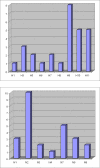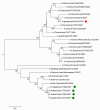Avian influenza virus monitoring in wintering waterbirds in Iran, 2003-2007
- PMID: 20167132
- PMCID: PMC2837633
- DOI: 10.1186/1743-422X-7-43
Avian influenza virus monitoring in wintering waterbirds in Iran, 2003-2007
Abstract
Background: Virological, molecular and serological studies were carried out to determine the status of infections with avian influenza viruses (AIV) in different species of wild waterbirds in Iran during 2003-2007. Samples were collected from 1146 birds representing 45 different species with the majority of samples originating from ducks, coots and shorebirds. Samples originated from 6 different provinces representative for the 15 most important wintering sites of migratory waterbirds in Iran.
Results: Overall, AIV were detected in approximately 3.4% of the samples. However, prevalence was higher (up to 8.3%) at selected locations and for certain species. No highly pathogenic avian influenza, including H5N1 was detected. A total of 35 AIVs were detected from cloacal or oropharyngeal swab samples. These positive samples originated mainly from Mallards and Common Teals.Of 711 serum samples tested for AIV antibodies, 345 (48.5%) were positive by using a nucleoprotein-specific competitive ELISA (NP-C-ELISA). Ducks including Mallard, Common Teal, Common Pochard, Northern Shoveler and Eurasian Wigeon revealed the highest antibody prevalence ranging from 44 to 75%.
Conclusion: Results of these investigations provide important information about the prevalence of LPAIV in wild birds in Iran, especially wetlands around the Caspian Sea which represent an important wintering site for migratory water birds. Mallard and Common Teal exhibited the highest number of positives in virological and serological investigations: 43% and 26% virological positive cases and 24% and 46% serological positive reactions, respectively. These two species may play an important role in the ecology and perpetuation of influenza viruses in this region. In addition, it could be shown that both oropharyngeal and cloacal swab samples contribute to the detection of positive birds, and neither should be neglected.
Figures




Similar articles
-
Low pathogenic influenza A virus activity at avian interfaces in Ohio zoos, 2006-2009.Avian Dis. 2013 Sep;57(3):657-62. doi: 10.1637/10528-031313-Reg.1. Avian Dis. 2013. PMID: 24283133
-
Avian influenza survey in migrating waterfowl in Sonora, Mexico.Transbound Emerg Dis. 2011 Feb;58(1):63-8. doi: 10.1111/j.1865-1682.2010.01182.x. Epub 2010 Nov 22. Transbound Emerg Dis. 2011. PMID: 21091641
-
Consecutive natural influenza a virus infections in sentinel mallards in the evident absence of subtype-specific hemagglutination inhibiting antibodies.Transbound Emerg Dis. 2013 Oct;60(5):395-402. doi: 10.1111/j.1865-1682.2012.01357.x. Epub 2012 Jul 22. Transbound Emerg Dis. 2013. PMID: 22816511
-
[Surveillance of wild birds for avian influenza A virus (AIV) in Bavaria in the years 2007 and 2008].Berl Munch Tierarztl Wochenschr. 2009 Nov-Dec;122(11-12):486-93. Berl Munch Tierarztl Wochenschr. 2009. PMID: 19999383 Review. German.
-
Avian influenza A viruses in birds --an ecological, ornithological and virological view.Dtsch Tierarztl Wochenschr. 2005 Dec;112(12):448-56. Dtsch Tierarztl Wochenschr. 2005. PMID: 16425630 Review.
Cited by
-
Full-length characterization and phylogenetic analysis of hemagglutinin gene of H9N2 virus isolated from broilers in Iran during 1998-2007.Comp Clin Path. 2013;22(3):321-330. doi: 10.1007/s00580-012-1405-x. Epub 2012 Jan 21. Comp Clin Path. 2013. PMID: 32214973 Free PMC article.
-
Surveillance of influenza viruses in waterfowl used as decoys in Andalusia, Spain.PLoS One. 2014 Jun 5;9(6):e98890. doi: 10.1371/journal.pone.0098890. eCollection 2014. PLoS One. 2014. PMID: 24901946 Free PMC article.
-
Genetic Characterization of Kazakhstan Isolates: Avian Influenza H9N2 Viruses Demonstrate Their Potential to Infect Mammals.Viruses. 2025 May 8;17(5):685. doi: 10.3390/v17050685. Viruses. 2025. PMID: 40431696 Free PMC article.
-
Detection of H3N8 influenza A virus with multiple mammalian-adaptive mutations in a rescued Grey seal (Halichoerus grypus) pup.Virus Evol. 2020 Mar 18;6(1):veaa016. doi: 10.1093/ve/veaa016. eCollection 2020 Jan. Virus Evol. 2020. PMID: 32211197 Free PMC article.
-
Avian Influenza Virus and Avian Paramyxoviruses in Wild Waterfowl of the Western Coast of the Caspian Sea (2017-2020).Viruses. 2024 Apr 12;16(4):598. doi: 10.3390/v16040598. Viruses. 2024. PMID: 38675939 Free PMC article.
References
-
- Stallknecht DE, Brown JD. In: Avian Influenza. 1. Swayne DE, editor. Blackwell Publishing, Ames, Iowa; 2008. Ecology of Avian Influenza in Wild Birds; pp. 43–58. full_text.
-
- FAO EMPRES-I database. Emergency Centre for Transboundary Animal Diseases (ECTAD), Animal Health Service. Rome, Italy: Food and Agriculture Organization of the United Nations; 2007.
-
- Commission Decision 2006/437/EC approving a diagnostic manual for avian influenza as provided for in Council Directive 2005/94/EC. Off J Eur Commun. 2006;L237:1–27.
MeSH terms
Substances
LinkOut - more resources
Full Text Sources
Medical
Miscellaneous

